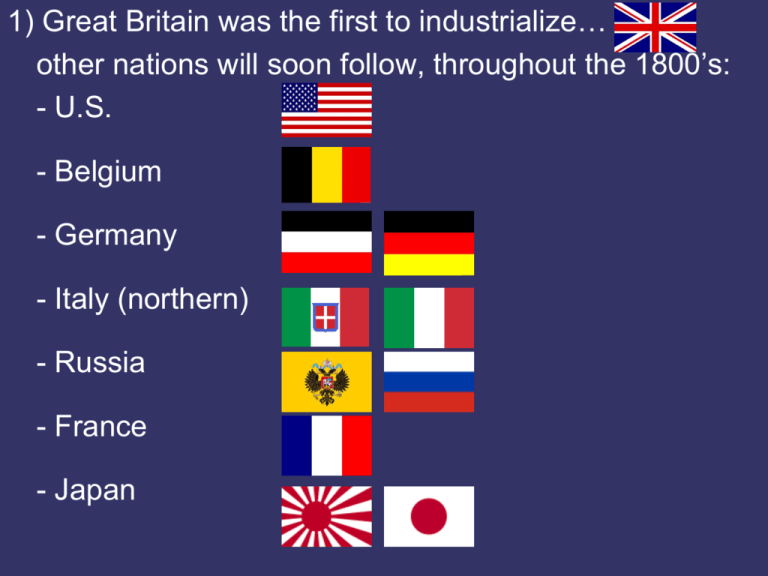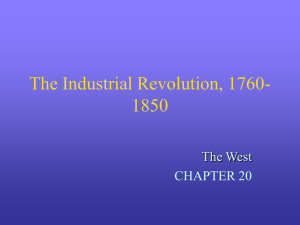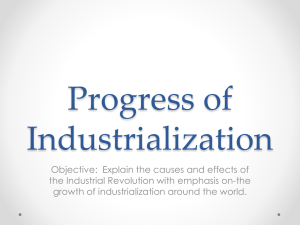Document
advertisement

1) Great Britain was the first to industrialize… other nations will soon follow, throughout the 1800’s: - U.S. - Belgium - Germany - Italy (northern) - Russia - France - Japan … also industrializing, but much more slowly: - Spain - Austria-Hungary - Bohemia (today: Czech Republic) 2) Each of these nations possessed common factors of production, to varying degrees: - Resources (rivers, coal, iron ore) - Labor force - Entrepreneurship (inc. British emigrants, other nations sending their youth to British universities) - Government encouragement & investment (i.e infrastructure - esp. railroads). MELTING! 3) Early U.S. industrialization (early 1800’s): - Resources (rivers, coal, iron ore) - Growing labor force (women leaving farms; immigrants) - Entrepreneurship of British emigrants w/ expertise in textile production (i.e. Slater, Lowell) - War of 1812: British blockade of U.S. coast encouraged domestic economic independence & entrepreneurship. 4) U.S. industrialization: - Began in the Northeast (New England) - U.S. industrialization dramatically increases after the Civil War (after 1865). 4) Post Civil War U.S. industrial growth dramatically increases (cont.): - Increasing utilization of more resources (coal, iron, OIL) - Growth of inventions & innovations (light bulb, telephone) - Rapidly growing immigrant population in cities = inexpensive labor pool + more consumers. - Dramatic increase in railroads & city growth as transit points for flow of raw materials and finished goods. 5) Businesses get bigger, stronger: the CORPORATION Businesses sell SHARES of ownership (STOCK) to raise CAPITAL for growth. Corporate charter granted by the state. - Benefits to investor (shareholder): Entitled to share of profits (or loss), proportionate to # of shares owned, w/ returns via increased stock value or paid dividends. Not personally liable for debt or litigation Limits risk only to amount of investment - Benefits to corporation: raise more capital w/ less debt spreads risk across many investors limits liability (but establishes reporting standards & disclosure requirements) As corporations get larger, they get more powerful, economically AND POLITICALLY 5) Corporations (cont.): Corporate goal: maximize… … PROFIT … control of an entire industry As major producers (and employers), corporations can historically demand longer hours and lower wages, to provide shareholders w/ larger profits (further encouraging more investment). Ex: Standard Oil, Carnegie Steel 5) Corporations (cont.) - Corporate power: - Corporations have limited liability for potentially abusive and immoral practices, AND are “people” with constitutional rights - Can become “too big to fail” (immortal “people”?), as large employers and major drivers of the economy - Money = speech = disproportionate influence over electoral politics (voter messaging, candidate spending,) lobbying, public policy 6) Turmoil in Europe = a head start for Britain: - French Revolution (1789-1799), giving way to… - Rise of Napoleon, Napoleonic Wars (1800-1815) … both will bog down continental Europe in war & instability, delaying industrial growth for the rest of Europe, while allowing Britain to build an early economic lead. 7) German industrialization (achieved by late 1800’s): Disadvantages to overcome (early 1800’s): - Politically divided = no cohesive government or economic policy (multiple small German kingdoms will not unify as a nation until 1871) - Scattered resources & isolated pockets of production (+ lack of infrastructure to link resources, production, & markets) German Industrialization takes off: - Copies UK entrepreneurial model (imports technology, sends Germans to UK for industrial education) (beg. 1835) - Massive investment in infrastructure (esp. railroads) to link resources, cities, and markets 7) German industrialization achieved, late 19th century: - Politically unified = strong government support - Growing military = security, protection, expansion … ALL the factors of production are coordinated (“MELTING”) … Germany will rival Britain as an industrial and military power (beg. 1884). 8) Japanese industrialization (late 1800’s): - Change in political leadership in 1868, followed by significant public (government) investment in factors of production to encourage private enterprise (“MELTING”) - Like other industrial nations, Japan then invests in a MILITARY build-up, and becomes increasingly IMPERIALISTIC (taking what they need from other nations, rather than trading for it). 9) Global impacts of expanding industrialization: - Increased trade and interdependency among nations – both rich and poor, producers and providers (of resources and labor) = GLOBALIZATION - Increased economic competition and international tension - Increased poverty and exploitation of underdeveloped nations - Growing wealth gap (GDP) between industrial and nonindustrial nations 10) Imperialism: When a nation controls other nations for economic, political, and/or military gain. 11) Growing industrialization (and international competition) increases demand for: - RESOURCES (inc. raw materials AND cheap labor) - MARKETS (consumers) Any nation can acquire both of these via trade; militaristic & imperial nations can acquire both by force, further gaining an unfair competitive advantage over other industrial nations. Increasing industrialization & global competition: Britain US Germany France Belgium Italy Russia Japan … ALL will industrialize, militarize, and imperialize in the 1800’s… what will this lead to in the 1900’s? WORLD WAR I… and WORLD WAR II 12) Industrial nations gain wealth and health, and a growing middle class. A growing middle class will lead directly to: - expanding educational opportunities - democratization People will gradually become more informed, affluent, comfortable, and will demand an increased political voice in their lives… leading to an end to monarchy as a dominant political system!





